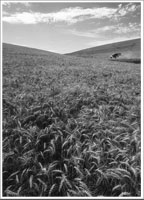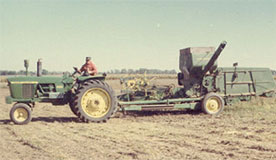
|
17th century
Tobacco is the first important American export
18th century
Colonies export tobacco, rice, indigo, grain, and meat products
1789
First tariff act, for revenue only
1789-1860
The tariff is a perennial subject of contention between the agricultural
interests of the South and West and the commercial interests of the
North
1790
Value of tobacco exports:
$4.36 million or 44% of total exports
|
|
 |
1800-09
Average
annual value of agricultural exports: $23 million or 75% of total
exports
1810-19
Agricultural
exports: $40 million/year or 87% of total exports
1815-60
Cotton is by far the most important agricultural export
1816
Tariff of 1816 includes protection for wool, sugar, hemp, and flax
|
|
 |
1820-29
Agricultural
exports: $42 million/year or 65% of total exports
1828
Tariff of Abominations opposed by the agricultural South
1830-39
Agricultural exports: $74 million/year or 73%
of total exports
1833
Tariff Act of 1833 begins tariff-reducing trend that lasts until the
Civil War
|
|
 |
1840-49
Agricultural
exports: $90 million/year or 65% of total exports
1850-59
Agricultural exports: $189 million/year or 81%
of total exports
1851-60
Cotton exports: $124 million per year or 54% of total exports
1854-57
Crimean War provides boom for U.S. agricultural exports, especially
wheat
|
|
 |
1860-69
Agricultural
exports: $182 million/year or 75% of total exports
1865-80
Wheat exports increase sharply
1870-79
Agricultural
exports: $453 million/year or 79% of total exports
1871
Horace Capron mission to develop Japanese agriculture
|
|
 |

1880-89
Agricultural
exports: $574 million/year or 76% of total exports
1890-99
Agricultural exports: $703 million/year or 71%
of total exports
1890
McKinley Tariff includes many agricultural commodities
|
|
 |

 1900-09 1900-09
 Agricultural
exports: $917 million/year or 58% Agricultural
exports: $917 million/year or 58%
 of total exports of total exports
 1905 1905
 International Institute of Agriculture established International Institute of Agriculture established
|
|
 |

1910-19
Agricultural
exports: $1.9 billion/year or 45% of total exports
1913
USDA's Office of Markets established to promote farm marketing
|
|
 |
1920-29
Agricultural
exports: $1.94 billion/year or 42% of total exports
1921-22
Tariff acts raise rates for agricultural and other imports
|
|
 |
1930-39
Agricultural
exports: $765 million/year or 32% of total exports
1930
Hawley-Smoot tariff raises rates to prohibitive levels, prompting
retaliation from other countries
1939
Technical agricultural collaboration with South American countries
|
|
 |
1940-49
Agricultural
exports: $2.42 billion/year or 22% of total exports
1940-46
Overseas assistance during wartime emergency
1945
United Nations Relief and Rehabilitation Administration established
1945
Food and Agriculture Organization of the Untied Nations established
1946
International Emergency Food Council established
1947
General Agreement on Tariffs and Trade (GATT) establishes working
procedures that have substantially reduced tariffs between member
nations
1948
Foreign Assistance Act provides for European Recovery Program
1949
International Wheat Program
|
|
 |

1950-59
Agricultural
exports: $3.53 billion/year or 22% of total exports
1954
Agricultural Trade Development and Assistance Act (Food for Peace)
|
|
 |

 1960-69 1960-69
 Agricultural exports: $5.76 Agricultural exports: $5.76
 billion/year or 22.9% of total exports billion/year or 22.9% of total exports
 1964 1964
 Trade Expansion Act Trade Expansion Act
|
|
 |
1970-79
Agricultural
exports: $19.8 billion/year or 19% of total exports
1971
Consultative Group on International Agricultural Research organized
to fund regional research institutes in developing countries
1972
I ncreased exports to Soviet Union and elsewhere absorb agricultural
surpluses, especially of grains and oilseeds
1979
Grain embargo against the Soviet Union following its invasion of Afghanistan
|
|
 |
1980-89
Agricultural
exports: $35.6 billion/year or 15% of total exports
1980s
European grain and animal exports become more competitive with U.S.
products
1981
U.S. agricultural exports peak at $43.8 billion, then decline until
1987; President Reagan lifts the grain embargo against the Soviet
Union
1988
The U.S.-Canada trade accord initiates free trade in all commodities
|
|
 |
1990
One
farmer supplies 100 persons (est.)
1990s
Information technology and precision techniques increasingly used
in agriculture
|
|
| |
Next Category >>
|







 Back to Index
Back to Index  Back to Top
Back to Top 







 Back to Index
Back to Index  Back to Top
Back to Top 